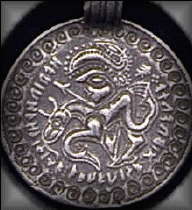Merseburg Incantations
2007 Schools Wikipedia Selection. Related subjects: General Literature
The Merseburg Incantations (German: die Merseburger Zaubersprüche) are two medieval magic spells, charms or incantations, written in Old High German. They are the only known examples of Germanic pagan belief preserved in this language. They were discovered in 1841 by Georg Waitz, who found them in a theological manuscript from Fulda, written in the 9th or 10th century, although there remains some speculation about the date of the charms themselves. The manuscript (Cod. 136 f. 85a) was stored in the library of the cathedral chapter of Merseburg, hence the name.
Form
Each charm is divided into two parts: a preamble telling the story of a mythological event; and the actual spell in the form of a magic analogy (just as it was before... so shall it also be now...). In their verse form, the spells are of a transitional type; the lines show not only alliteration but also the end-rhymes developed in the Christian verse of the 9th century.
History
Among the preliterate early Germanic tribes, incantations had the function "of rendering usable, through captive words, the magic powers which people wished to make serve them" They have survived in large numbers, particularly from the area of the Germanic languages. However, they all date from the Middle Ages and therefore bear the stamp or show the influence of Christianity. What is unique about the Merseburg Incantations is that they still reflect very clearly their pre-Christian origin (from before the year 750). They were written down for an unknown reason in the 10th century by a literate cleric, possibly in the abbey of Fulda, on a blank page of a liturgical book, which later passed to the library at Merseburg. The incantations have thus been transmitted in Caroline minuscule on the flyleaf of a Latin sacramentary.
The spells became famous in modern times through the appreciation of the Grimm brothers, who wrote as follows:
- Lying between Leipzig, Halle and Jena, the extensive library of the Cathedral Chapter of Merseburg has often been visited and made use of by scholars. All have passed over a codex which, if they chanced to take it up, appeared to offer only well-known church items, but which now, valued according to its entire content, offers a treasure such that the most famous libraries have nothing to set beside it..."
The spells were published later by the Brothers Grimm in On two newly-discovered poems from the German Heroic Period ( 1842) and are now preserved in the library of Merseburg Cathedral.
Incantation 1: Liberation of prisoners
The first spell is a "Lösesegen" (blessing of release), describing a number of " Idisen" ( Valkyrie women, ) being told to free from their shackles the warriors caught during battle. The last two lines contain the magic words "Leap forth from the fetters, escape from the foes" that are intended to release the warriors.
|
Eiris sazun idisi |
Once the Idisi set forth, |
Once sat women, |
Incantation 2: Horse cure
Phol (possibly another name for Balder) is with Wodan (Odin) when Balder's horse dislocates its foot while riding through the forest (holza). Odin is saying as a result: "Bone to bone, blood to blood, limb to limb, as if they were glued". Images from the 5th-6th century show Odin healing a horse. Unfortunately, the other gods' names cannot be identified inequivocally; the only clear names are "Uuôdan" (Wodan, Wotan, Odin) and "Frîia" ( Freyja, one of Odin's lovers). As for the other names, it is not even sure whether they really are names of gods, since different interpretations of their translation are available.

|
Phol ende uuodan sose benrenki, |
Phol and Odin Bone-sprain, |
Phol and Wodan If a bone-wrenching, |
Adaptations
Many German rock groups and musicians have been inspired by the Merseburg Incantations and produced their own settings. The already "classic" adaptation of the first incantation comes from the group Ougenweide; it is a free invention based on no real musical tradition. The group In Extremo, whose song Küss mich (Kiss me) was in the 2003 charts, included a version of the first incantation in their album Verehrt und angespien (Honoured and spat at) in 1999 and of the second in their album Sünder ohne Zügel (Sinners without reins) in 2001. Also in that year they did the same in the project Helium Vola in a quite different context. The band Corvus Corax features both charms in a single song on the album Ante Casu Peccati (Before the Fall). Yet another adaptation was featured by Tanzwut, a musical project of Corvus Corax, in the album of the same title. A further band, Nagelfar, has included the incantations on Die Sprüche auf Virus West.
None of these reinterpretations is based on the medieval melodies.
Other
The manuscript of the Merseburg Incantations was on display until November 2004 as part of the exhibition "Between Cathedral and World - 1000 years of the Chapter of Merseburg", at Merseburg cathedral. They were previously exhibited in 1939.
The incantations can be found "freely translated" into English by D. L. Ashliman at his website.
